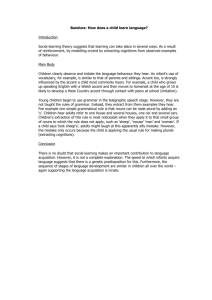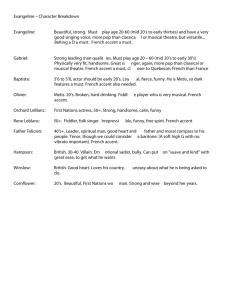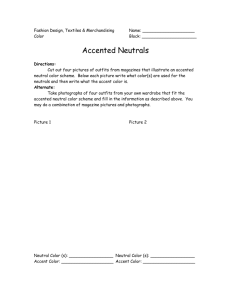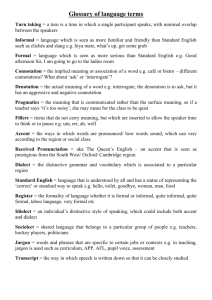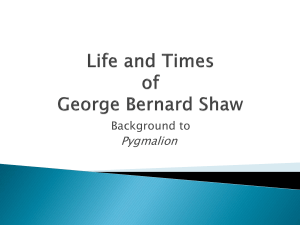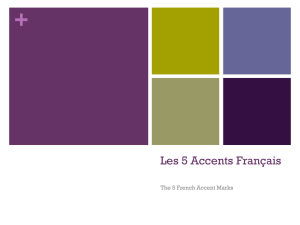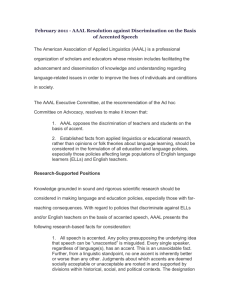P00-1030
advertisement
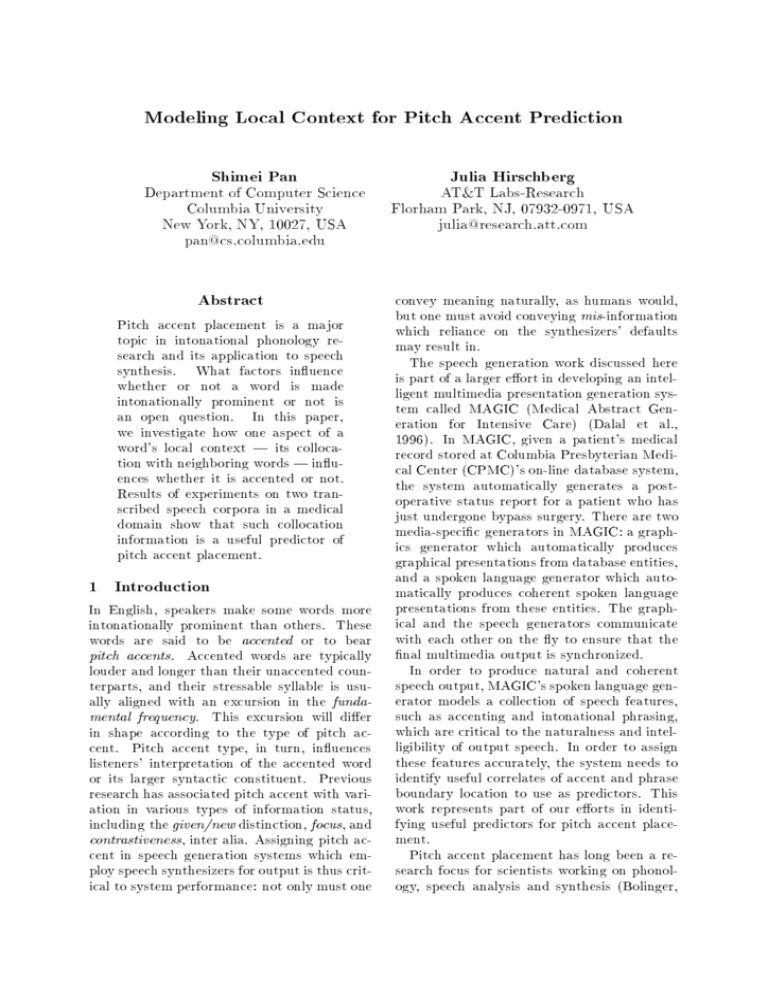
Modeling Local Context for Pitch Accent Prediction
Shimei Pan
Department of Computer Science
Columbia University
New York, NY, 10027, USA
pan@cs.columbia.edu
Abstract
Pitch accent placement is a major
topic in intonational phonology research and its application to speech
synthesis. What factors inuence
whether or not a word is made
intonationally prominent or not is
an open question. In this paper,
we investigate how one aspect of a
word's local context | its collocation with neighboring words | inuences whether it is accented or not.
Results of experiments on two transcribed speech corpora in a medical
domain show that such collocation
information is a useful predictor of
pitch accent placement.
1 Introduction
In English, speakers make some words more
intonationally prominent than others. These
words are said to be accented or to bear
pitch accents. Accented words are typically
louder and longer than their unaccented counterparts, and their stressable syllable is usually aligned with an excursion in the fundamental frequency.
This excursion will dier
in shape according to the type of pitch accent. Pitch accent type, in turn, inuences
listeners' interpretation of the accented word
or its larger syntactic constituent. Previous
research has associated pitch accent with variation in various types of information status,
including the given/new distinction, focus, and
contrastiveness, inter alia. Assigning pitch accent in speech generation systems which employ speech synthesizers for output is thus critical to system performance: not only must one
Julia Hirschberg
AT&T Labs-Research
Florham Park, NJ, 07932-0971, USA
julia@research.att.com
convey meaning naturally, as humans would,
but one must avoid conveying mis-information
which reliance on the synthesizers' defaults
may result in.
The speech generation work discussed here
is part of a larger eort in developing an intelligent multimedia presentation generation system called MAGIC (Medical Abstract Generation for Intensive Care) (Dalal et al.,
1996). In MAGIC, given a patient's medical
record stored at Columbia Presbyterian Medical Center (CPMC)'s on-line database system,
the system automatically generates a postoperative status report for a patient who has
just undergone bypass surgery. There are two
media-specic generators in MAGIC: a graphics generator which automatically produces
graphical presentations from database entities,
and a spoken language generator which automatically produces coherent spoken language
presentations from these entities. The graphical and the speech generators communicate
with each other on the y to ensure that the
nal multimedia output is synchronized.
In order to produce natural and coherent
speech output, MAGIC's spoken language generator models a collection of speech features,
such as accenting and intonational phrasing,
which are critical to the naturalness and intelligibility of output speech. In order to assign
these features accurately, the system needs to
identify useful correlates of accent and phrase
boundary location to use as predictors. This
work represents part of our eorts in identifying useful predictors for pitch accent placement.
Pitch accent placement has long been a research focus for scientists working on phonology, speech analysis and synthesis (Bolinger,
1989; Ladd, 1996). In general, syntactic features are the most widely used features in
pitch accent predication. For example, partof-speech is traditionally the most useful single pitch accent predictor (Hirschberg, 1993).
Function words, such as prepositions and articles, are less likely to be accented, while
content words, such as nouns and adjectives,
are more likely to be accented. Other linguistic features, such as inferred given/new
status (Hirschberg, 1993; Brown, 1983), contrastiveness (Bolinger, 1961), and discourse
structure (Nakatani, 1998), have also been examined to explain accent assignment in large
speech corpora. In a previous study (Pan and
McKeown, 1998; Pan and McKeown, 1999), we
investigated how features such as deep syntactic/semantic structure and word informativeness correlate with accent placement. In this
paper, we focus on how local context inuences
accent patterns. More specically, we investigate how word collocation inuences whether
nouns are accented or not.
Determining which nouns are accented and
which are not is challenging, since part-ofspeech information cannot help here. So, other
accent predictors must be found. There are
some advantages in looking only at one word
class. We eliminate the interaction between
part-of-speech and collocation, so that the inuence of collocation is easier to identify. It
also seems likely that collocation may have a
greater impact on content words, like nouns,
than on function words, like prepositions.
Previous researchers have speculated that
word collocation aects stress assignment of
noun phrases in English. For example, James
Marchand (1993) notes how familiar collocations change their stress, witness the American
pronunciation of `Little House' [in the television series Little House on the Prairie], where
stress used to be on HOUSE, but now, since the
series is so familiar, is placed on the LITTLE.
That is, for collocated words, stress shifts to
the left element of the compound. However,
there are numerous counter-examples: consider apple PIE, which retains a right stress
pattern, despite the collocation. So, the extent to which collocational status aects accent patterns is still unclear.
Despite some preliminary investigation
(Liberman and Sproat, 1992), word collocation information has not, to our knowledge,
been successfully used to model pitch accent
assignment; nor has it been incorporated into
any existing speech synthesis systems. In this
paper, we empirically verify the usefulness of
word collocation for accent prediction. In Section 2, we describe our annotated speech corpora. In Section 3, we present a description of
the collocation measures we investigated. Section 4 to 7 describe our analyses and machine
learning experiments in which we attempt to
predict accent location. In Section 8 we sum
up our results and discuss plans for further research.
2 Speech Corpora
From the medical domain described in Section
1, we collected two speech corpora and one text
corpus for pitch accent modeling. The speech
corpora consist of one multi-speaker spontaneous corpus, containing twenty segments and
totaling fty minutes, and one read corpus of
ve segments, read by a single speaker and totaling eleven minutes of speech. The text corpus consists of 3.5 million words from 7375 discharge summaries of patients who had undergone surgery. The speech corpora only cover
cardiac patients, while the text corpus covers
a larger group of patients and the majority of
them have also undergone cardiac surgery.
The speech corpora were rst transcribed orthographically and then intonationally, using
the ToBI convention for prosodic labeling of
standard American English (Silverman et al.,
1992). For this study, we used only binary accented/deaccented decisions derived from the
ToBI tonal tier, in which location and type
of pitch accent is marked. After ToBI labeling, each word in the corpora was tagged with
part-of-speech, from a nine-element set: noun,
verb, adjective, adverb, article, conjunction,
pronoun, cardinal, and preposition. The spontaneous corpus was tagged by hand and the
read tagged automatically. As noted above,
we focus here on predicting whether nouns are
accented or not.
3 Collocation Measures
We used three measures of word collocation to
examine the relationship between collocation
and accent placement: word bigram predictability, mutual information, and the
Dice coefficient. While word predictability is not typically used to measure collocation,
there is some correlation between word collocation and predictability. For example, if two
words are collocated, then it will be easy to
predict the second word from the rst. Similarly, if one word is highly predictable given
another word, then there is a higher possibility
that these two words are collocated. Mutual
information (Fano, 1961) and the Dice coeÆcient (Dice, 1945) are two standard measures
of collocation. In general, mutual information
measures uncertainty reduction or departure
from independence. The Dice coeÆcient is a
collocation measure widely used in information
retrieval. In the following, we will give a more
detailed denitions of each.
Statistically, bigram word predictability is
dened as the log conditional probability of
word wi, given the previous word wi 1:
( ) = log (P rob(wijwi 1))
P red wi
Bigram predictability directly measures the
likelihood of seeing one word, given the
occurrence of the previous word.
Bigram predictability has two forms: absolute and relative. Absolute predictability is
the value directly computed from the formula. For example, given four adjacent
words wi 1 ; wi; wi+1 and wi+2 , if we assume
P rob(wi jwi 1 ) = 0:0001, P rob(wi+1 jwi ) =
0:001, and P rob(wi+2 jwi+1) = 0:01, the absolute bigram predictability will be -4, -3 and
-2 for wi ; wi+1 and wi+2 . The relative predictability is dened as the rank of absolute
predictability among words in a constituent.
In the same example, the relative predictability will be 1, 2 and 3 for wi ; wi+1 and wi+2 ,
where 1 is associated with the word with the
lowest absolute predictability. In general, the
higher the rank, the higher the absolute predictability. Except in Section 7, all the predictability measures mentioned in this paper
use the absolute form.
We used our text corpus to compute bigram
word predictability for our domain. When calculating the word bigram predictability, we
rst ltered uncommon words (words occurring 5 times or fewer in the corpus) then used
the Good-Turing discount strategy to smooth
the bigram. Finally we calculated the log conditional probability of each word as the measure of its bigram predictability.
Two measures of mutual information were
used for word collocation: pointwise mutual information, which is dened as :
Pr (wi 1 ; wi )
1 (wi 1; wi) = log P (w )P (w )
r
i 1
r
i
I
and average
is dened as:
mutual information,
which
2 (wi 1; wi) =
I
Pr (wi 1 ; wi )
1 ; wi) log P (w )P (w )
r
i 1
r
i
Pr (wi 1 ; wi )
+Pr (wi 1; wi) log
Pr (wi 1 )Pr (wi )
P (w
;w )
+Pr (wi 1; wi) log r i 1 i
Pr (wi 1 )Pr (wi )
P (w
;w )
+Pr (wi 1; wi) log r i 1 i
Pr (wi 1 )Pr (wi )
(
Pr wi
The same text corpus was used to compute
both mutual information measures. Only word
pairs with bigram frequency greater than ve
were retained.
The Dice coeÆcient is dened as:
(
Dice wi
1; wi) =
2 Pr (wi 1 ; wi)
Pr (wi 1 ) + Pr (wi )
Here, we also use a cut o threshold of ve to
lter uncommon bigrams.
Although all these measures are correlated,
one measure can score word pairs quite dierently from another. Table 1 shows the top ten
collocations for each metric.
In the predictability top ten list, we have
pairs like scarlet fever where fever is very predictable from scarlet (in our corpus, scarlet is
always followed by fever), thus, it ranks highest in the predictability list. Since scarlet can
be diÆcult to predict from fever, these types
of pairs will not receive a very high score using mutual information (in the top 5% in I1
sorted list and in the top 20% in I2 list) and
Dice coeÆcient (top 22%). From this table, it
is also quite clear that I1 tends to rank uncommon words high. All the words in the top
ten I1 list have a frequency less than or equal
Pred
I1
I2
Dice
chief complaint
polymyalgia rheumatica
The patient
greeneld lter
cerebrospinal uid
hemiside stepper
present illness
Guillain Barre
folic acid
Pepto Bismol
hospital course
Viet Nam
periprocedural complications
Glen Cove
po
Neo Synephrine
normoactive bowel
hydrogen peroxide
physical exam
polymyalgia rheumatica
uric acid
Viet Nam
id
hemiside stepper
postpericardiotomy syndrome
Neo Synephrine
coronary artery
Pepto Bismol
Staten Island
otitis media
postoperative day
Glen Cove
scarlet fever
Lo Gerfo
saphenous vein
present illness
pericardiotomy syndrome
Chlor Trimeton
medical history
chief complaint
Table 1: Top Ten Most Collocated Words for Each Measure
to seven (we lter all the pairs occurring fewer
than six times).
Of the dierent metrics, only bigram predictability is a unidirectional measure. It captures how the appearance of one word aects
the appearance of the following word. In contrast, the other measures are all bidirectional
measures, making no distinction between the
relative position of elements of a pair of collocated items. Among the bidirectional measures, point-wise mutual information is sensitive to marginal probabilities Pr (wordi 1) and
Pr (wordi ). It tends to give higher values as
these probabilities decrease, independently of
the distribution of their co-occurrence. The
Dice coeÆcient, however, is not sensitive to
marginal probability. It computes conditional
probabilities which are equally weighted in
both directions.
Average mutual information measures the
reduction in the uncertainty, of one word,
given another, and is totally symmetric. Since
I2 (wordi 1 ;
wordi )=I2 (wordi ;wordi 1 ), the
uncertainty reduction of the rst word, given
the second word, is equal to the uncertainty reduction of the second word, given the
rst word. Further more, because I2 (wordi;
wordi 1 ) = I2 (wordi ;wordi 1 ), the uncertainty reduction of one word, given another,
is also equal to the uncertainty reduction of
failing to see one word, having failed to see
the other.
Since there is considerable evidence that
prior discourse context, such as previous mention of a word, aects pitch accent decisions,
it is possible that symmetric measures, such
as mutual information and the Dice coeÆcient, may not model accent placement as
well as asymmetric measures, such as bigram
predictability. Also, the bias of point-wise
mutual information toward uncommon words
can aect its ability to model accent assignment, since, in general, uncommon words are
more likely to be accented (Pan and McKeown, 1999). Since this metric disproportionately raises the mutual information for uncommon words, making them more predictable
than their appearance in the corpus warrants,
it may predict that uncommon words are more
likely to be deaccented than they really are.
4
Statistical Analyses
In order to determine whether word collocation is useful for pitch accent prediction,
we rst employed Spearman's rank correlation
test (Conover, 1980).
In this experiment, we employed a unigram
predictability-based baseline model. The unigram predictability of a word is dened as
the log probability of a word in the text corpus. The maximum likelihood estimation of
this measure is:
log
P
( )
( )
F req wi
i F req wi
The reason for choosing this as the baseline
model is not only because it is context independent, but also because it is eective. In
a previous study (Pan and McKeown, 1999),
we showed that when this feature is used, it
is as powerful a predictor as part-of-speech.
When jointly used with part-of-speech information, the combined model can perform signicantly better than each individual model.
When tested on a similar medical corpus, this
combined model also outperforms a comprehensive pitch accent model employed by the
Bell Labs' TTS system (Sproat et al., 1992;
Hirschberg, 1993; Sproat, 1998), where discourse information, such as given/new, syntactic information, such as POS, and surface information, such as word distance, are incorporated. Since unigram predictability is context
independent. By comparing other predictors
to this baseline model, we can demonstrate the
impact of context, measured by word collocation, on pitch accent assignment.
Table 2 shows that for our read speech
corpus, unigram predictability, bigram predictability and mutual information are all signicantly correlated (p < 0:001) with pitch accent decision.1 However, the Dice coeÆcient
shows only a trend toward correlation (p <
0:07). In addition, both bigram predictability and (pointwise) mutual information show a
slightly stronger correlation with pitch accent
than the baseline. When we conducted a similar test on the spontaneous corpus, we found
that all but the baseline model are signicantly
correlated with pitch accent placement. Since
all three models incorporate a context word
while the baseline model does not, these results suggest the usefulness of context in accent prediction. Overall, for all the dierent
measures of collocation, bigram predictability
explains the largest amount of variation in accent status for both corpora. We conducted a
similar test using trigram predictability, where
two context words, instead of one, were used
to predict the current word. The results are
slightly worse than bigram predictability (for
the read corpus r = 0:167, p < 0:0001; for
the spontaneous r = 0:355, p < 0:0001).
The failure of the trigram model to improve
over the bigram model may be due to sparse
data. Thus, in the following analysis, we focus
on bigram predictability. In order to further
verify the eectiveness of word predictability
in accent prediction, we will show some examples in our speech corpora rst. Then we will
describe how machine learning helps to derive
pitch accent prediction models using this feature. Finally, we show that both absolute predictability and relative predictability are useful for pitch accent prediction.
1
Since pointwise mutual information performed consistently better than average mutual information in our
experiment, we present results only for the former.
5
Word Predictability and Accent
In general, nouns, especially head nouns, are
very likely to be accented. However, certain nouns consistently do not get accented.
For example, Table 3 shows some collocations
containing the word cell in our speech corpus. For each context, we list the collocated
pair, its most frequent accent pattern in our
corpus (upper case indicates that the word
was accented and lower case indicates that
it was deaccented), its bigram predictability
(the larger the number is, the more predictable
the word is), and the frequency of this accent pattern, as well as the total occurrence
of the bigram in the corpus. In the rst exWord Pair
[of] CELL
[RED] CELL
[PACKED] cell
[BLOOD] cell
Table 3:
cell
Pred(cell)
-3.11
-1.119
-0.5759
-0.067
Freq
7/7
2/2
4/6
2/2
Collocations
ample, cell in [of ] CELL is very unpredictable
from the occurrence of of and always receives a
pitch accent. In [RED] CELL, [PACKED] cell,
and [BLOOD] cell, cell has the same semantic
meaning, but dierent accent patterns: cell in
[PACKED] cell and [BLOOD] cell is more predictable and deaccented, while in [RED] CELL
it is less predictable and is accented. These
examples show the inuence of context and
its usefulness for bigram predictability. Other
predictable nouns, such as saver in CELL
saver usually are not accented even when they
function as head nouns. Saver is deaccented in
ten of the eleven instances in our speech corpus. Its bigram score is -1.5517, which is much
higher than that of CELL (-4.6394{3.1083 depending upon context). Without collocation
information, a typical accent prediction system is likely to accent saver, which would be
inappropriate in this domain.
6
Accent Prediction Models
Both the correlation test results and direct observations provide some evidence on the usefulness of word predictability. But we still need to
demonstrate that we can successfully use this
feature in automatic accent prediction. In order to achieve this, we used machine learning
Corpus
Read
r
Baseline (Unigram)
Bigram Predictability
Pointwise Mutual Information
Dice CoeÆcient
=
=
r =
r =
r
r
0:166
0:236
0:185
0:079
p-value
p = 0:0002
p < 0:0001
p < 0:0001
p = 0:066
Spontaneous
p-value
0:02
p = 0:39
0:36 p < 0:0001
0:177 p < 0:0001
0:094 p < 0:0001
r
=
=
r =
r =
r
r
Table 2: Correlation of Dierent Collocation Measures with Accent Decision
techniques to automatically build accent prediction models using bigram word predictability scores.
We used RIPPER (Cohen, 1995b) to explore the relations between predictability and
accent placement. RIPPER is a classicationbased rule induction system. From annotated
examples, it derives a set of ordered if-then
rules, describing how input features can be
used to predict an output feature. In order
to avoid overtting, we use 5-fold cross validation. The training data include all the nouns in
the speech corpora. The independent variables
used to predict accent status are the unigram
and bigram predictability measures, and the
dependent variable is pitch accent status. We
used a majority-based predictability model as
our baseline (i.e. predict accented).
In the combined model, both unigram and
bigram predictability are used together for accent prediction. From the results in Table 4,
we see that the bigram model consistently outperforms the unigram model, and the combined model achieves the best performance.
To evaluate the signicance of the improvements achieved by incorporating a context
word, we use the standard error produced by
RIPPER. Two results are statistically significant when the results plus or minus twice
the standard error do not overlap (Cohen,
1995a). As shown in Table 4, for the read
corpus, except for the unigram model, all the
models with bigram predictability performed
signicantly better than the baseline model.
However, the bigram model and the combined
model failed to improve signicantly over the
unigram model. This may result from too
small a corpus. For the spontaneous corpus,
the unigram, bigram and the combined model
all achieved signicant improvement over the
baseline. The bigram also performed signicantly better than the unigram model. The
combined model had the best performance. It
also achieved signicant improvement over the
unigram model.
The improvement of the combined model
over both unigram and bigram models may
be due to the fact that some accent patterns
that are not captured by one are indeed captured by the other. For example, accent patterns for street names have been extensively
discussed in the literature (Ladd, 1996). For
example, street in phrases like (e.g. FIFTH
street) is typically deaccented while avenue
(e.g. Fifth AVENUE) is accented. While it
seems likely that the conditional probability
of Pr (S treetjF if th) is no higher than that of
Pr (AvenuejF if th), the unigram probability of
Pr (street) is probably higher than that of avenue Pr (avenue).2. So, incorporating both
predictability measures may tease apart these
and similar cases.
7
Relative Predictability
In the our previous analysis, we showed the effectiveness of absolute word predictability. We
now consider whether relative predictability is
correlated with a larger constituent's accent
pattern. The following analysis focuses on accent patterns of non-trivial base NPs.3 For
this study we labeled base NPs by hand for
the corpora described in Section 2. For each
base NP, we calculate which word is the most
predictable and which is the least. We want
to see, when comparing with its neighboring
2
For example, in a 7.5M word general news corpus
(from CNN and Reuters), street occurs 2115 times and
avenue just 194. Therefore, the unigram predictability of street is higher than that of avenue. The most
common bigram with street is Wall Street which occurs
116 times and the most common bigram with avenue is
Pennsylvania Avenue which occurs 97. In this domain,
the bigram predictability for street in Fifth Street is extremely low because this combination never occurred,
while that for avenue in Fifth Avenue is -3.0995 which
is the third most predictable bigrams with avenue as
the second word.
3
Non-recursive noun phrases containing at least two
elements.
Corpus
Predictability Model
baseline model
unigram model
Read
bigram predictability model
unigram+bigram model
baseline model
unigram model
Spontaneous bigram model
unigram+bigram model
Performance Standard Error
81.98%
82.86%
0.93
84.41%
1.10
85.03%
1.04
70.03%
72.22%
0.62
74.46%
0.30
77.43%
0.51
Table 4: Ripper Results for Accent Status Prediction
Model
Predictability
Total Accented Word Not Accented Accentability
unigram Least Predictable 1206
877
329
72.72%
Most Predictable 1198
485
713
40.48%
bigram Least Predictable 1205
965
240
80.08%
Most Predictable 1194
488
706
40.87%
Table 5: Relative Predictability and Accent Status
words, whether the most predictable word is
more likely to be deaccented. As shown in Table 5, the \total" column represents the total
number of most (or least) predictable words
in all baseNPs4 . The next two columns indicate how many of them are accented and deaccented. The last column is the percentage of
words that are accented. Table 5 shows that
the probability of accenting a most predictable
word is between 40:48% and 45:96% and that
of a least predictable word is between 72:72%
and 80:08%. This result indicates that relative predictability is also a useful predictor for
a word's accentability.
8
Discussion
It is diÆcult to directly compare our results
with previous accent prediction studies, to
determine the general utility of bigram predictability in accent assignment, due to differences in domain and the scope of our task.
For example, Hirschberg (1993) built a comprehensive accent prediction model using machine learning techniques for predicting accent status for all word classes for a text-tospeech system, employing part-of-speech, various types of information status inferred from
the text, and a number of distance metrics,
as well as a complex nominal predictor developed by Sproat (1992). An algorithm making
use of these features achieved 76.5%-80% accent prediction accuracy for a broadcast news
4
The total number of most predictable words is not
equal to that of least predictable words due to ties.
corpus, 85% for sentences from the ATIS corpus of spontaneous elicited speech, and 98.3%
success on a corpus of laboratory read sentences. Liberman and Sproat's (1992) success
in predicting accent patterns for complex nominals alone, using rules combining a number
of features, achieved considerably higher success rates (91% correct, 5.4% acceptable, 3.6%
unacceptable when rated by human subjects)
for 500 complex nominals of 2 or more elements chosen from the AP Newswire. Our results, using bigram predictability alone, 77%
for the spontaneous corpus and 85% for the
read corpus, and using a dierent success estimate, while not as impressive as (Liberman
and Sproat, 1992)'s, nonetheless demonstrate
the utility of a relatively untested feature for
this task.
In this paper, we have investigated several
collocation-based measures for pitch accent
prediction. Our initial hypothesis was that
word collocation aects pitch accent placement, and that the more predictable a word
is in terms of its local lexical context, the
more likely it is to be deaccented. In order
to verify this claim, we estimated three collocation measures: word predictability, mutual information and the Dice coeÆcient. We
then used statistical techniques to analyze the
correlation between our dierent word collocation metrics and pitch accent assignment
for nouns. Our results show that, of all the
collocation measures we investigated, bigram
word predictability has the strongest correla-
tion with pitch accent assignment. Based on
this nding, we built several pitch accent models, assessing the usefulness of unigram and
bigram word predictability {as well as a combined model{ in accent predication. Our results show that the bigram model performs
consistently better than the unigram model,
which does not incorporate local context information. However, our combined model performs best of all, suggesting that both contextual and non-contextual features of a word
are important in determining whether or not
it should be accented.
These results are particularly important for
the development of future accent assignment
algorithms for text-to-speech. For our continuing research, we will focus on two directions.
The rst is to combine our word predictability
feature with other pitch accent predictors that
have been previously used for automatic accent
prediction. Features such as information status, grammatical function, and part-of-speech,
have also been shown to be important determinants of accent assignment. So, our nal
pitch accent model should include many other
features. Second, we hope to test whether the
utility of bigram predictability can be generalized across dierent domains. For this purpose, we have collected an annotated AP news
speech corpus and an AP news text corpus,
and we will carry out a similar experiment in
this domain.
9 Acknowledgments
Thanks for C. Jin, K. McKeown, R. Barzilay, J. Shaw, N. Elhadad, M. Kan, D. Jordan, and anonymous reviewers for the help on
data preparation and useful comments. This
research is supported in part by the NSF Grant
IRI 9528998, the NLM Grant R01 LM06593-01
and the Columbia University Center for Advanced Technology in High Performance Computing and Communications in Healthcare.
References
D. Bolinger. 1961. Contrastive accent and contrastive stress. language, 37:83{96.
D. Bolinger. 1989. Intonation and Its Uses. Stanford University Press.
G. Brown. 1983. Prosodic structure and the
given/new distinction. In A. Cutler and D.R.
Ladd, ed., Prosody: Models and Measurements,
pages 67{78. Springer-Verlag, Berlin.
P. Cohen. 1995a. Empirical methods for articial
intelligence. MIT press, Cambridge, MA.
W. Cohen. 1995b. Fast eective rule induction.
In Proc. of the 12th International Conference on
Machine Learning.
W. J. Conover. 1980. Practical Nonparametric
Statistics. Wiley, New York, 2nd edition.
M. Dalal, S. Feiner, K. McKeown, S. Pan, M. Zhou,
T. Hoellerer, J. Shaw, Y. Feng, and J. Fromer.
1996. Negotiation for automated generation of
temporal multimedia presentations. In Proc. of
ACM Multimedia 96, pages 55{64.
Lee R. Dice. 1945. Measures of the amount of
ecologic association between species. Journal of
Ecology, 26:297{302.
Robert M. Fano. 1961. Transmission of Information: A Statistical Theory of Communications.
MIT Press, Cambridge, MA.
J. Hirschberg. 1993. Pitch accent in context: predicting intonational prominence from text. Articial Intelligence, 63:305{340.
D. Robert Ladd. 1996. Intonational Phonology.
Cambridge University Press, Cambridge.
M. Liberman and R. Sproat. 1992. The stress and
structure of modied noun phrases in English.
In I. Sag, ed., Lexical Matters, pages 131{182.
University of Chicago Press.
J. Marchand. 1993. Message posted on HUMANIST mailing list, April.
C. Nakatani. 1998. Constituent-based accent prediction. In Proc. of COLING/ACL'98, pages
939{945, Montreal, Canada.
S. Pan and K. McKeown. 1998. Learning intonation rules for concept to speech generation. In
Proc. of COLING/ACL'98, Montreal, Canada.
S. Pan and K. McKeown. 1999. Word informativeness and automatic pitch accent modeling.
In Proc. of the Joint SIGDAT Conference on
EMNLP and VLC, pages 148{157.
K. Silverman, M. Beckman, J. Pitrelli, M. Ostendorf, C. Wightman, P. Price, J. Pierrehumbert,
and J. Hirschberg. 1992. ToBI: a standard for
labeling English prosody. In Proc. of ICSLP92.
R. Sproat, J. Hirschberg, and D. Yarowsky. 1992.
A corpus-based synthesizer. In Proc. of ICSLP92, pages 563{566, Ban.
R. Sproat, ed. 1998. Multilingual Text-to-Speech
Synthesis: The Bell Labs Approach. Kluwer.
